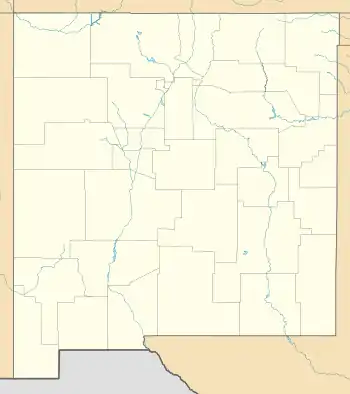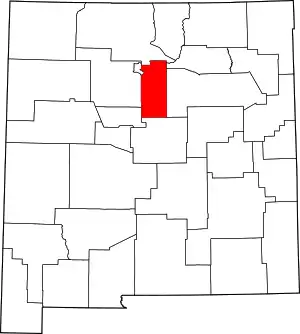Bonanza City, New Mexico
Bonanza City is a ghost town, located 13 miles (21 km) southwest of Santa Fe in Santa Fe County, New Mexico, United States.[1] The town was founded in 1880 as a mining town, following the discovery of gold and silver in the nearby Cerrillos Hills. It was later abandoned sometime in the early 1900s. Later in the twentieth century, The Bonanza Creek Movie Ranch, which contains a movie set depicting a late 19th century mining town, was built near the ruins of Bonanza City. Kid Nation, a 2007 television series taking place in a fictionalized version of Bonanza City, was filmed on the movie ranch.

Background

The Cerrillos Hills are a grouping of hills in modern-day New Mexico containing deposits of valuable resources including silver, gold, lead, copper, and turquoise.[2][3] The Pueblo have mined for turquoise in the hills as early as the 900s CE.[2][3] During the 16th and 17th centuries, the colonizing Spanish used Pueblo slave labor to mine turquoise, as well as lead and silver.[2][3] In 1680, the Pueblo revolted against the Spanish and temporarily drove them from Santa Fe de Nuevo México (modern-day New Mexico); with the exception of a few sporadic mining operations, wide-scale mining would not occur again until the late 1800s.[note 1]
Ownership of the Cerrillos Hills region passed to Mexico in 1821 following the Mexican War of Independence and then to the United States in 1848 following the Mexican–American War. In May 1879, the administration of President Ulysses S. Grant began selling land in New Mexico, including the Cerrillos Hills region, to the American public.[4] Later that year, two miners from Colorado discovered gold and silver deposits within the Cerrillos Hills, which lead to a mining boom and the establishment of numerous mining towns around the Cerrillos Hills.[2][4] In September 1879, the Los Cerrillos Mining District was established to regulate mining claims within the region.[5] By the end of 1880, at least 500 mining shafts had been opened within the district.[6]
Original town

Bonanza City was founded in 1880 by John Mahoney, the former US consul to Algiers.[1][10] Bonanza is Spanish for "prosperity" or "rich ore pocket";[10] Bonanza City was one of the many mining towns founded after the discovery of valuable minerals in the Los Cerrillos hills.[2][11] By July 1881, the town contained a store, post office, hotel, and smelter;[1] Bonanza City also had a church and priest at some point in the early 1880s.[7] The town however lacked important amenities such as a barbershop, shoemaker, and a general merchandise store.[1] Bonanza City had a population of up to 2,000 people,[10] presumably at some point from 1880 to 1883.[1]
In 1883, the Bonanza City post office closed, while the smelter was transported to Albuquerque after Bonanza failed to provide enough ore.[1][12][13] The population of Bonanza City dropped to 200 by 1884, although some demand for miners existed for another year or so.[1] The town went into further decline following 1885 and was largely abandoned by 1890.[1][7] Bonanza City experienced a temporary revival in the early 1900s after the construction of a small smelter,[7] but was ultimately completely abandoned at some point in the early 20th century.[note 3] Today, all that remains of the original town are building foundations and the ruins of the smelter.[1]
Use as a filming location
The Bonanza Creek Movie Ranch is located near the ruins of Bonanza City.[note 4] The Hughes family obtained the ranch during the 1940s.[20] The family has used the ranch as a filming location since the early 1950s, when scenes from The Man from Laramie were filmed there.[21] Dozens of films, including Silverado, The Legend of the Lone Ranger, and A Million Ways to Die in the West, have since been filmed in part or entirely on the ranch.[20] The 2007 television show Kid Nation, which aired for one season on CBS, was also filmed on the ranch.[19] The series tasked forty children, ranging in age from 8 to 15, with revitalizing a fictionalized version of Bonanza City and correcting the supposed mistakes of the city's original residents.[22][19] The show proved controversial and faced claims of child exploitation.[23][19]
The earliest films produced on the ranch either took place outdoors or used facades.[21] Starting in the 1980s, a permanent movie set was constructed on the ranch by the Hughes family and various production companies.[21][19] The set consists of complete, free standing buildings that are supplied with water and electricity.[21]
Notes
- The Spanish reconquered the territory in 1692,[2] and mined for lead to produce bullets.[4] During the late 1700s, the Spanish started giving mining grants for land containing turquoise.[4] During the 1800s, limited prospecting occurred in the region which resulted in the occasional discovery of gold.[4]
- Secord & Milford claim that the image is of Bonanza City.[7] The specific stenograph this image was copied from labeled the picture as the "Marshall Bonanza Property";[8] this was the name of a single-shaft mine located in the Los Cerrillos Mining District.[9]
- Coverage from local newspapers indicates that the town was still populated during the 1900s and that the area was recognized as a town into at least the early 1910s.[14]
- Bonanza City was located immediately south of Alamo Creek (formerly the Los Cerrillos Creek) while the Bonanza Creek Movie Ranch is located immediately north of Alamo Creek.[7][15][16] The Bonanza Creek Movie Ranch nonetheless maintains that the ranch is constructed on the ruins of Bonanza City.[17] Both the television series Kid Nation and a TelevisionWeek article reviewing the series reiterate this claim.[18][19]
References
- Sherman & Sherman, p. 19.
- Julyan 2006, p. 102.
- Disbrow & Stoll, p. 52.
- Lawson, p. 11.
- Hayward, p. 9.
- Hayward, p. 6.
- Secord & Milford, p. 25.
- "Marshall Bonanza property, Los Cerrillos mining district, New Mexico". New Mexico Digital Collections. University of New Mexico Libraries. Retrieved January 16, 2020.
- Hayward, p. 63.
- Julyan 1996, p. 45.
- Hayward, p.5.
- "The Hubbs Smelter Again". Albuquerque Morning Journal. Page two. 8 October 1882. Retrieved 10 January 2020.
- Greene, p. 126.
- See for example:
- "Personal Mention". Santa Fe New Mexican. Page four. 2 May 1906. Retrieved 3 January 2020.
Edgar Andrews and D. Conley, miners from Bonanza, were in the city [of Santa Fe] yesterday and purchased supplies.
- "Personal Mention". Santa Fe New Mexican. Page four. 25 July 1906. Retrieved 3 January 2020.
Edgar Andrews, a miner, was in the city [of Santa Fe] yesterday from Bonanza.
- "Personal Mention". Santa Fe New Mexican. Page two. 6 April 1912. Retrieved 3 January 2020.
William L. McClure, who owns an interest in the Thomas ranch near Bonanza, arrived in the city [of Santa Fe] last evening...
- "Personal Mention". Santa Fe New Mexican. Page four. 2 May 1906. Retrieved 3 January 2020.
- Hayward, p. 105.
- Google (13 January 2020). "Bonanza Creek Ranch" (Map). Google Maps. Google. Retrieved 13 January 2020.
- "Our History". Bonanza Creek Ranch. Retrieved January 13, 2020.
- Karsh, Jonathan (host) (19 September 2007). "I'm Trying to be a Leader Here!". Kid Nation. Event occurs at 0 minutes 5 seconds. CBS.
- Hibberd, James (16 July 2007). "The Founding of 'Kid Nation'". TelevisionWeek. 26 (29): 1, 22 – via ProQuest.
- Seymore, Jami (8 May 2019), Santa Fe’s Bonanza Creek Ranch Movie Sets Catching the Eye of Netflix. KRQE. Retrieved 2 January 2020. Archived from the original 2 January 2020.
- Wall, Dennis (June 1994). "Movie Towns Set Stage for a Western Revival" (PDF). New Mexico Magazine. Archived from the original (PDF) on 2 January 2020. Retrieved 2 January 2020.
- Cianci, pp.366-367.
- Cianci, p. 365.
Bibliography
- Cianci, Christopher (Winter 2009). "Entertainment or Exploitation?: Reality Television and the Inadequate Protection of Child Participants Under the Law". Southern California Interdisciplinary Law Journal. 18: 363–394.
- Disbrow, Alan E.; Stoll, Walter C. (1957). Geology of the Cerrillos Area, Santa Fe County, New Mexico (PDF). New Mexico Bureau of Mining & Technology.
- Greene, Chas. W. (1883). "Progress of Mining Industry". In Rich, William G. Illustrated New Mexico. New Mexican Printing and Publishing Company. pp. 124–130. Retrieved 11 January 2020.
- Hayward, J. Lyman (1880). The Los Cerrillos Mines and their Mineral Resources. University of New Mexico Press.
- Julyan, Robert (1996). The Place Names of New Mexico. University of New Mexico Press. ISBN 9780826316899.
- Julyan, Robert (2006). The Mountains of New Mexico. University of New Mexico Press. ISBN 0826335152.
- Lawson, Jacqueline E. (1989). Yesterday, Today, and Tomorrow: The Story of a Won't-be Ghost Town. Sunstone Press. ISBN 0865341303.
- Secord, Paul R.; Milford, Homer E. (2018). Galisteo Basin and Cerrillos Hills, The. Arcadia Publishing. ISBN 9781467127189.
- Sherman, James; Sherman, Barbara (1979). Ghost Towns and Mining Camps of New Mexico. University of Oklahoma Press. ISBN 0-8061-1106-2. Retrieved 5 December 2011.
